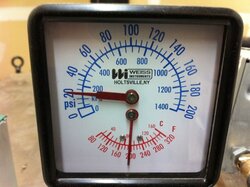I have said many times that draft is one of the most critical issues for proper operation with this style boiler. I posted this thread last year: https://www.hearth.com/econtent/index.php/forums/viewthread/53980/. Basically I just say how much better my unit performs with proper draft after having run with out the draft inducer for a few weeks.
I am also a huge advocate of storage. Most especially in shoulder seasons. But when the temps. turn cold I find it just as easy to burn 24/7 and use storage as a high temp dump zone. I like the convenience of a constantly lit boiler and I may use a tad bit less wood.
This week the temps have been cold enough to run 24/7 but in the back of my mind I was hesitant because I remembered last year when I ran a constant fire/no storage. I did not like the smell the boiler was making in my cellar and I noticed a small amount of dripping from the side panels on the bottom. I figured if the cellar was smelling of creosote I knew my hex and chimney were getting mucked up. So I went back to running storage.
Here comes the epiphany: I have been running non stop for 4 days and it occurred to me there was absolutely no bad small, no dripping. and when I checked the hex it was clean. What was so different hmmmm. I finally figured out that last year I had the draft inducer uninstalled at the time I was trying to run 24/7. Now it is installed again and whamo no problems at all.
So this is what I think is going on. When the damper first closes the wood inside the boiler smokes for a while before it enters the "charcoal mode". That trapped smoke is what causes the creosote build up and moisture issues. With my draft inducer still running, it is sucking that crap right out of the unit and sending it up the chimney. Now I know this will cause a bit more wood usage BUT it is minimal. I still get 12 hour burns easy enough. For you guys with the additional damper in the stove pipe, the problem is even more magnified.
I have seen so many posts with people complaining about creosote and moisture issues. I always thought I was immune because of storage but now I think people with severe problems are lacking draft and especially draft induction.
Anyway, I just thought this theory is strong enough for other people to experiment with...
I am also a huge advocate of storage. Most especially in shoulder seasons. But when the temps. turn cold I find it just as easy to burn 24/7 and use storage as a high temp dump zone. I like the convenience of a constantly lit boiler and I may use a tad bit less wood.
This week the temps have been cold enough to run 24/7 but in the back of my mind I was hesitant because I remembered last year when I ran a constant fire/no storage. I did not like the smell the boiler was making in my cellar and I noticed a small amount of dripping from the side panels on the bottom. I figured if the cellar was smelling of creosote I knew my hex and chimney were getting mucked up. So I went back to running storage.
Here comes the epiphany: I have been running non stop for 4 days and it occurred to me there was absolutely no bad small, no dripping. and when I checked the hex it was clean. What was so different hmmmm. I finally figured out that last year I had the draft inducer uninstalled at the time I was trying to run 24/7. Now it is installed again and whamo no problems at all.
So this is what I think is going on. When the damper first closes the wood inside the boiler smokes for a while before it enters the "charcoal mode". That trapped smoke is what causes the creosote build up and moisture issues. With my draft inducer still running, it is sucking that crap right out of the unit and sending it up the chimney. Now I know this will cause a bit more wood usage BUT it is minimal. I still get 12 hour burns easy enough. For you guys with the additional damper in the stove pipe, the problem is even more magnified.
I have seen so many posts with people complaining about creosote and moisture issues. I always thought I was immune because of storage but now I think people with severe problems are lacking draft and especially draft induction.
Anyway, I just thought this theory is strong enough for other people to experiment with...


